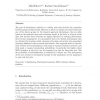Free Online Productivity Tools
i2Speak
i2Symbol
i2OCR
iTex2Img
iWeb2Print
iWeb2Shot
i2Type
iPdf2Split
iPdf2Merge
i2Bopomofo
i2Arabic
i2Style
i2Image
i2PDF
iLatex2Rtf
Sci2ools
CSDA
2004
2004
Fast and robust discriminant analysis
The goal of discriminant analysis is to obtain rules that describe the separation between groups of observations. Moreover it allows to classify new observations into one of the known groups. In the classical approach discriminant rules are often based on the empirical mean and covariance matrix of the data, or of parts of the data. But because these estimates are highly influenced by outlying observations, they become inappropriate at contaminated data sets. Robust discriminant rules are obtained by inserting robust estimates of location and scatter into generalized maximum likelihood rules at normal distributions. This approach allows to discriminate between several populations, with equal or unequal covariance structure, and with equal or unequal membership probabilities. In particular the highly robust MCD estimator is used as it can be computed very fast for large data sets. Also the probability of misclassification is estimated in a robust way. The performance of the new method ...
| Added | 17 Dec 2010 |
| Updated | 17 Dec 2010 |
| Type | Journal |
| Year | 2004 |
| Where | CSDA |
| Authors | Mia Hubert, Katrien van Driessen |
Comments (0)

